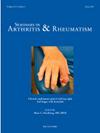No disproportionate reporting of inflammatory arthritis following COVID-19 vaccination: a pharmacovigilance study using VAERS data
IF 4.4
2区 医学
Q1 RHEUMATOLOGY
引用次数: 0
Abstract
Objectives
To assess whether inflammatory arthritis was disproportionately reported as an adverse event following COVID-19 vaccination compared to other vaccines, using data from the Vaccine Adverse Event Reporting System (VAERS).
Methods
We performed a retrospective analysis of VAERS data from December 2020 to December 2024, focusing on inflammatory arthritis as adverse event following administration of the BNT162b2, mRNA-1273, and Ad26.COV2.S vaccines. Data on vaccine dose, demographic characteristics, and symptom onset were collected. A structured query based on MedDRA terms was used to identify the reports of inflammatory arthritis. Crude reporting rate of arthritis was calculated. Disproportionality analysis was conducted using the proportional reporting ratio (PRR), reporting odds ratio (ROR), and Bayesian information component (IC), initially comparing COVID-19 vaccines to all other vaccines in VAERS, and then with stratification by age, sex, and comparator vaccine (influenza and herpes zoster).
Results
Among 651,850 valid reports, 5580 events of inflammatory arthritis were identified, yielding a CRR of 13.8 cases per million doses administered. Most reports involved females (72 %) and occurred within a median of 2 days post-vaccination. In the overall population, inflammatory arthritis was not disproportionately reported after COVID-19 vaccination (PRR: 0.999, 95 % CI: 0.883 to 1.130; ROR: 0.878, 95 % CI: 0.777 to 0.994; IC: –0.008, 95 % CrI: –0.046 to 0.030). Disproportionality analysis in subgroups confirmed the absence of signal across age and sex strata.
Conclusion
Our findings demonstrate that there is no disproportionate reporting of inflammatory arthritis following COVID-19 vaccination compared to other vaccines, supporting the overall safety of COVID-19 vaccines.
COVID-19疫苗接种后没有不成比例的炎症性关节炎报告:使用VAERS数据的药物警戒研究
目的利用疫苗不良事件报告系统(VAERS)的数据,评估与其他疫苗相比,COVID-19疫苗接种后炎症性关节炎作为不良事件的报告是否不成比例。方法回顾性分析2020年12月至2024年12月的VAERS数据,重点关注炎症性关节炎作为给药BNT162b2、mRNA-1273和Ad26.COV2后的不良事件。年代的疫苗。收集了疫苗剂量、人口统计学特征和症状发作的数据。基于MedDRA术语的结构化查询用于识别炎性关节炎的报告。计算关节炎的粗报告率。采用比例报告比(PRR)、报告优势比(ROR)和贝叶斯信息分量(IC)进行歧化分析,首先将COVID-19疫苗与VAERS中所有其他疫苗进行比较,然后按年龄、性别和比较疫苗(流感和带状疱疹)分层。结果在651850份有效报告中,发现5580例炎症性关节炎事件,每百万剂量的CRR为13.8例。大多数报告涉及女性(72%),发生在接种疫苗后2天内。在总体人群中,接种COVID-19疫苗后,炎症性关节炎的发生率不不成比例(PRR: 0.999, 95% CI: 0.883 ~ 1.130; ROR: 0.878, 95% CI: 0.777 ~ 0.994; IC: -0.008, 95% CrI: -0.046 ~ 0.030)。亚组的歧化分析证实了跨年龄和性别阶层的信号缺失。结论我们的研究结果表明,与其他疫苗相比,接种COVID-19疫苗后没有不成比例的炎症性关节炎报告,支持COVID-19疫苗的总体安全性。
本文章由计算机程序翻译,如有差异,请以英文原文为准。
求助全文
约1分钟内获得全文
求助全文
来源期刊
CiteScore
9.20
自引率
4.00%
发文量
176
审稿时长
46 days
期刊介绍:
Seminars in Arthritis and Rheumatism provides access to the highest-quality clinical, therapeutic and translational research about arthritis, rheumatology and musculoskeletal disorders that affect the joints and connective tissue. Each bimonthly issue includes articles giving you the latest diagnostic criteria, consensus statements, systematic reviews and meta-analyses as well as clinical and translational research studies. Read this journal for the latest groundbreaking research and to gain insights from scientists and clinicians on the management and treatment of musculoskeletal and autoimmune rheumatologic diseases. The journal is of interest to rheumatologists, orthopedic surgeons, internal medicine physicians, immunologists and specialists in bone and mineral metabolism.

 求助内容:
求助内容: 应助结果提醒方式:
应助结果提醒方式:


